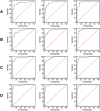Validation of a portable monitoring system for the diagnosis of obstructive sleep apnea syndrome
- PMID: 19480230
- PMCID: PMC2675898
- DOI: 10.1093/sleep/32.5.629
Validation of a portable monitoring system for the diagnosis of obstructive sleep apnea syndrome
Abstract
Study objective: To evaluate if a portable monitor could accurately measure the apnea-hypopnea index (AHI) in patients with a suspicion of obstructive sleep apnea (OSA).
Design: Prospective and randomized.
Setting: Sleep laboratory.
Participants: 80 participants: 70 patients with clinical OSA suspicion and 10 subjects without suspicion of OSA.
Interventions: N/A.
Measurements and results: Three-order randomized evaluations were performed: (1) STD (Stardust II) used at the participants' home (STD home), (2) STD used simultaneously with PSG in the sleep lab (STD+PSG lab), and (3) PSG performed without the STD (PSG lab). Four AHI values were generated and analyzed: (a) STD home; (b) STD from STD+PSG lab; (c) PSG from STD+PSG (named PSG+STD lab); and (d) PSG lab. Two technicians, blinded to study details, performed the analyses of all evaluations. There was a strong correlation between AHI from the STD and PSG recordings for all 4 AHI values (all correlations above 0.87). Sensitivity, specificity, and positive and negative predictive values at AHI cut-off values of 5, 15, and 30 events/hour were calculated. AHI values from the PSG lab and PSG+STD lab were compared to STD home and STD+PSG lab and showed the best results when STD and PSG were performed simultaneously. In all analyses, the area under ROC curve was at least 0.90. With multiple comparisons, diagnostic agreement was between 91% and 75%. The Bland Altman analyses showed strong agreement between AHI values from the STD and PSG recordings, especially when comparing the AHI from simultaneous STD and PSG recordings.
Conclusion: These data suggest that the STD is accurate in confirming the diagnosis of OSA where there is a suspicion of the disorder. Better agreement occurred during simultaneous recordings.
Figures



Similar articles
-
Polysomnography in patients with obstructive sleep apnea: an evidence-based analysis.Ont Health Technol Assess Ser. 2006;6(13):1-38. Epub 2006 Jun 1. Ont Health Technol Assess Ser. 2006. PMID: 23074483 Free PMC article.
-
Evaluation of a single-channel portable monitor for the diagnosis of obstructive sleep apnea.J Clin Sleep Med. 2011 Aug 15;7(4):384-90. doi: 10.5664/JCSM.1196. J Clin Sleep Med. 2011. PMID: 21897775 Free PMC article.
-
Is portable monitoring for diagnosing obstructive sleep apnea syndrome suitable in elderly population?Sleep Breath. 2013 May;17(2):679-86. doi: 10.1007/s11325-012-0742-y. Epub 2012 Jul 4. Sleep Breath. 2013. PMID: 22752758 Clinical Trial.
-
Evaluation of a 2-channel portable device and a predictive model to screen for obstructive sleep apnea in a laboratory environment.Respir Care. 2015 Mar;60(3):356-62. doi: 10.4187/respcare.03626. Epub 2014 Nov 18. Respir Care. 2015. PMID: 25406349
-
Diagnostic accuracy of level IV portable sleep monitors versus polysomnography for obstructive sleep apnea: a systematic review and meta-analysis.Sleep Breath. 2018 Sep;22(3):593-611. doi: 10.1007/s11325-017-1615-1. Epub 2018 Jan 9. Sleep Breath. 2018. PMID: 29318566
Cited by
-
Post-Stroke Sleep-Disordered Breathing-Pathophysiology and Therapy Options.Front Surg. 2018 Feb 26;5:9. doi: 10.3389/fsurg.2018.00009. eCollection 2018. Front Surg. 2018. PMID: 29536012 Free PMC article. Review.
-
Management of sleep apnea without high pretest probability or with comorbidities by three nights of portable sleep monitoring.Sleep. 2014 Aug 1;37(8):1363-73. doi: 10.5665/sleep.3932. Sleep. 2014. PMID: 25083017 Free PMC article. Clinical Trial.
-
Severity of individual obstruction events is gender dependent in sleep apnea.Sleep Breath. 2017 May;21(2):397-404. doi: 10.1007/s11325-016-1430-0. Epub 2016 Dec 13. Sleep Breath. 2017. PMID: 27966055
-
Validation of a novel sleep-monitoring system for diagnosing obstructive sleep apnea: A comparison with polysomnography.Exp Ther Med. 2016 Nov;12(5):2937-2941. doi: 10.3892/etm.2016.3721. Epub 2016 Sep 20. Exp Ther Med. 2016. PMID: 27882098 Free PMC article.
-
Lower frequency of obstructive sleep apnea in spondyloarthritis patients taking TNF-inhibitors.J Clin Sleep Med. 2012 Dec 15;8(6):643-8. doi: 10.5664/jcsm.2254. J Clin Sleep Med. 2012. PMID: 23243397 Free PMC article.
References
-
- Kushida CA, Littner MR, Morgenthaler T, et al. Practice parameters for the indications for polysomnography and related procedures: An update for 2005. Sleep. 2005;28:499–521. - PubMed
-
- Collop NA, Anderson WM, Boehlecke B, et al. Portable Monitoring Task Force of the American Academy of Sleep Medicine. Clinical guidelines for the use of unattended portable monitors in the diagnosis of obstructive sleep apnea in adult patients. Portable Monitoring Task Force of the American Academy of Sleep Medicine. J Clin Sleep Med. 2007;3:737–47. - PMC - PubMed
-
- American Sleep Disorders Association. Practice parameters for use of portable recording in the assessment of obstructive sleep apnea. Sleep. 1994;17:372–77. - PubMed
-
- Schäfer H, Ewig S, Hasper E, Lüderitz B. Predictive diagnostic value of clinical assessment and non laboratory monitoring system recordings in patients with symptoms suggestive of obstructive sleep apnea syndrome. Respiration. 1997;64:194–9. - PubMed
-
- Westbrook PR, Levendowski DJ, Cvetinovic M, et al. Description and validation of the apnea risk evaluation system: a novel method to diagnose sleep apnea-hypopnea in the home. Chest. 2005;128:2166–75. - PubMed
Publication types
MeSH terms
LinkOut - more resources
Full Text Sources
Medical
Research Materials
Miscellaneous

